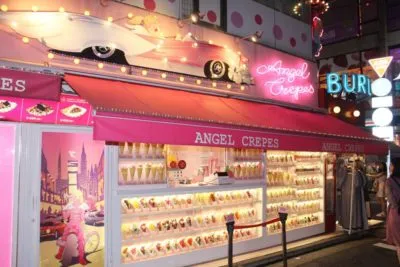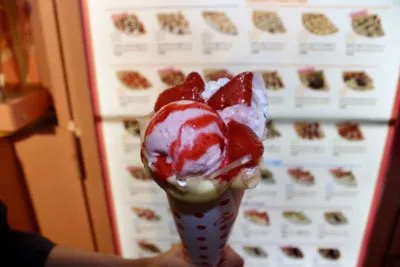Harajuku is a neighborhood in Tokyo that is known for its ‘kawaii’ (pretty/cute) fashion and extravagance. It radiates something different than any other neighborhood. The most famous place in Harajuku is Takeshita Street, where people from all over Japan and the world gather. They enjoy this unique neighborhood’s vibe and show off their best Harajuku-style outfits. One of the main reasons besides fashion to visit Harajuku is the sweet culture. All kinds of new sweets hit the scene here all the time, and two of its latest mainstays have been crepes and tapioca drinks.


Bubble Tea
Tapioca drinks, or Bubble Tea, consist of flavored tea that is often mixed with milk and sugar with black tapioca balls. The drink originally comes from Taiwan and has gained international popularity in recent years. In Japan, it is said that it became popular in the late 1990s, which was because some famous tapioca tea chain stores started business in Japan.
Ever since Bubble Tea shops have been a fixture in Harajuku and the number of shops only grew in 2018 because they enjoyed a resurge of popularity. One of the reasons why Bubble Tea became popular in Japan is because of its unique appearance and texture, and the possibility to make this versatile drink in many different awesome tasting flavors.
While in Japan it is customary to drink tea black (or usually ‘green’ in Japan’s case), they are very open to novel ideas when it comes to classic food and drinks. Besides being delicious, one of the most fun parts of drinking Bubble tea is sucking the tapioca balls from the bottom of the drink with a large straw. Also, because the chewy texture of tapioca reminds the Japanese a bit of mochi (rice cake), which is a traditional Japanese food, this new drink was easily accepted in Japan.
Nowadays, Bubble Tea doesn’t just come as milk tea but also as green tea, fruit tea, jasmine tea, and other types of Japanese or non-Japanese teas. As the beverage gradually spread in Japan and around the world, Bubble Tea baristas have continued to develop and incorporate new teas, flavors, blends, colors, and toppings. You’d be surprised how well cheese actually goes with sweet tea, so if you are in Harajuku, please don’t miss the opportunity to get a funky flavor or topping with your Bubble Tea!
Harajuku-style Crepes
Crepe is a traditional pancake-like dessert originally from the Brittany region of France and has spread throughout the world. This famous French sweet has taken on a kawaii form in Harajuku, full of cream, sugar, custard, and strawberries or other types of fruit. Teenagers (and those who used to be a teenager) love a good sweet, so once Marion Crepes opened up shop in Takeshita Street, all Tokyoites with a sweet tooth came to Harajuku to get their fix of sweet streetfood.
The crepes are always freshly prepared in front of the client, with a thin, pale yellow dough which is quickly poured and cooked on an iron, then folded and filled with a filling of your choice. The most popular is some variation of cream and fruit, but there are endless varieties that also include savory flavors like tasty tuna, pork chops, hot dogs, and curries. There are dozens of flavors and it is very simple to order because outside the store they display all models of crepes made with wax so that the client can give a graphic idea of how their crepe will be.
As Harajuku is the one place where (food) artists feel like they can safely experiment and young people are happily trying out new fashion, art, and foods, you will always find something new on the streets here. All in all, you can’t go to Harajuku without trying one of the eyecatching sweet street foods of Takeshita Street, so be sure to come hungry!
Your Japan Tour
As seasoned Japan experts, we create perfect Japan package tours including destinations like Harajuku. Check out our group tours and private tours, or contact us to start planning your unforgettable holiday to this fascinating country full of once-in-a-lifetime experiences, culture, history, nature, and delicious food!